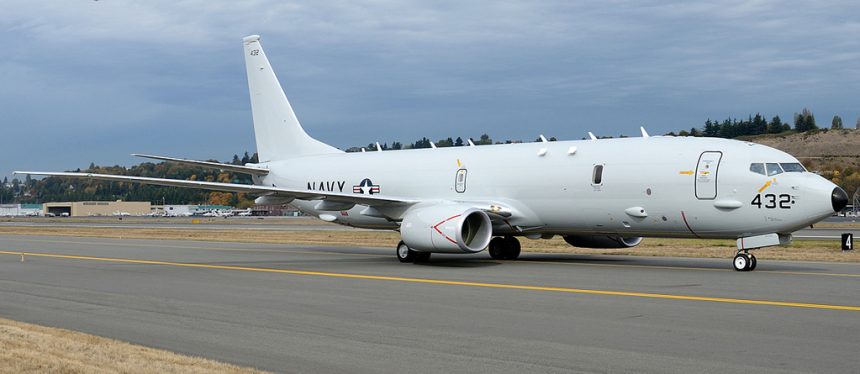Russia suggesting attack on airbase in Syria is linked to U.S. Navy maritime patrol aircraft presence.
Syrian and Russian media outlets including the state-run Sputnik News have reported that a U.S. Navy P-8A Poseidon surveillance aircraft flew in close proximity of the Russian Hmeymim (Khmeimim) airbase and Tartus naval facility in Syria during a recent attempted “swarm” attack by ISIS on Russian installations using thirteen improvised drones. The slant of the articles that appeared in Sputnik News on January 9, 2018 and in Almasdar News (AMN) on the same day suggest a connection between the attempted swarm attack, countered by the Russians, and the presence of the U.S. surveillance aircraft.
A quote published in the January 9, 2018 Sputnik article read, “This forces us to take a fresh look at the strange coincidence that, during the attack of UAV terrorists on Russian military facilities in Syria, the Navy reconnaissance aircraft Poseidon was on patrol over the Mediterranean Sea for more than 4 hours at an altitude of 7 thousand meters, between Tartus and Hmeymim.” The quote was attributed to the Russian Defense Ministry.
Another earlier incident from reports on December 30 and 31, 2017 claimed that, “US helicopters have evacuated Daesh leaders from several areas across the Syrian province of Deir ez-Zor to the country’s northeast.” (Note: “Daesh” is an Arabic language reference often used interchangeably with ISIS or ISIL). The reports surfaced in both “PressTV” reports and in an Almasdar News (AMN) media and a Pravda report.

Taken collectively, the tenor of the reports seems to feed a conspiracy theory that the U.S. may be providing some level of tacit or clandestine support to select members of ISIS in Syria. The reports come following Russia’s announcement of the withdrawal of most of its forces from Syria during a Dec. 13, 2017 visit by President Vladimir Putin.
Why Russia, or at least some Russian and state-oriented Syrian news agencies, have continued the narrative of U.S. collusion or secret support of ISIS without specific factual evidence remains a mystery. It may be to associate some greater national influence with any ISIS success in the region, suggesting ISIS itself is not capable enough to plan and execute these operations. Some of the reports surfaced on various Russian social media pages, but appear to have been removed in subsequent days. In contrast a new report published on January 9, 2018 in the Almasdar News (AMN) seems to back pedal on conspiracy claims, quoting a U.S. statement from official Pentagon spokesperson Maj. Adrian Rankin-Galloway that said, “The US military is concerned that combat drone technology used by terrorists in attempted attacks on two Russian facilities in Syria is available on the open market.”
The latest Almasdar News report did go on to say, “It is the first time when Daesh terrorists have used modern guidance technologies on satellite GPS. The Russian security services are carrying out a probe to find out who supplied the drones to terrorists.”
Defense journalist Joseph Trevithick wrote in a January 9, 2018 report in “The War Zone” that, “The assertion that the United States and its allies are actually in league with ISIS, which it sees as indistinct from other groups in Syria opposed to the regime of dictator Bashar Al Assad, is a long-standing conspiracy theory. This is not the first time the Russians have made such allegations, either. The latest string of attacks on Khmeimim is particularly uncomfortable, though, coming after Putin’s triumphant victory tour to Syria and other countries in the region in December 2017.”
The template for conspiracy theories of U.S. support of insurgents is a persistent one since the 1985-87 Iran-Contra controversy of the Reagan era, when the U.S. was implicated in supporting Iranian arms sales despite an embargo. History can trace similar instances back through the Vietnam conflict and earlier, and as recent as alleged support of Afghan guerillas led by Osama Bin Laden during their war against the then-Soviet Union when the U.S. was implicated with helping construct a training base in Khost, Afghanistan in support of training Mujahedeen guerillas to fight the Soviets.
Dealing with the P-8 Poseidon flying not far from Latakia, this is far from unusual. The aircraft, launched from NAS Sigonella, Italy, can be frequently tracked online while gathering intelligence during missions off Syria. As someone has suggested, the U.S. Navy aircraft was possibly snooping around in the aftermath of the swarm of drones attack on Hmeymim airbase to get some details about it.
By the way, it’s also worth noticing that these days, the U.S. ISR (Intelligence Surveillance Reconnaissance) aircraft seem to be interested in something else in the Crimea and Black Sea areas, considered the frequency of the sorties flown over there…
An hour on… Maritime patrol around Crimea & the Black Sea
🇺🇸 US Navy
P-8A Poseidon 168438 pic.twitter.com/pIcfOKMfMn
— CivMilAir ✈ (@CivMilAir) January 9, 2018









